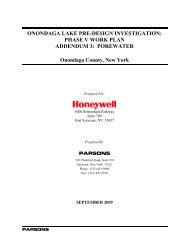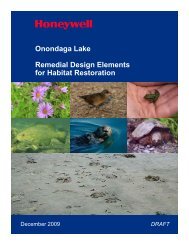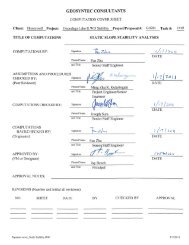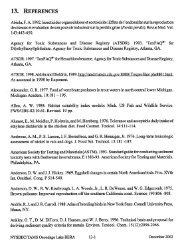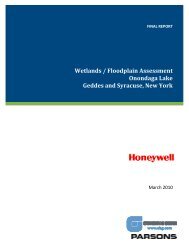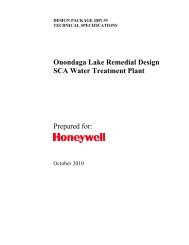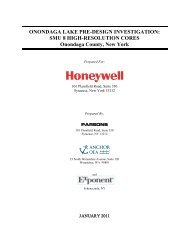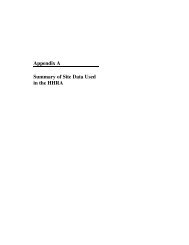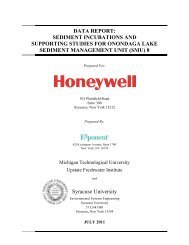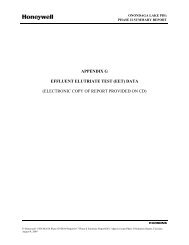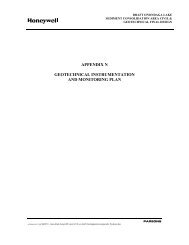Phase 1B Underwater Archaeological Report for the Onondaga ...
Phase 1B Underwater Archaeological Report for the Onondaga ...
Phase 1B Underwater Archaeological Report for the Onondaga ...
You also want an ePaper? Increase the reach of your titles
YUMPU automatically turns print PDFs into web optimized ePapers that Google loves.
FINAL<br />
<strong>Phase</strong> IB <strong>Underwater</strong> <strong>Archaeological</strong> Resources <strong>Report</strong> <strong>for</strong> <strong>Onondaga</strong> Lake Superfund Site<br />
Anomaly A3: Wooden Barge<br />
Anomaly 3 Summary Table<br />
Anomaly Identification Wooden Scow Barge; NY Site Number 06740.012293<br />
Remedial Impact<br />
Outside of remedial area, no adverse impact.<br />
NRHP Eligibility<br />
Eligible as Contributing Property to Syracuse Maritime Historic District<br />
Recommendation<br />
Anomaly Dataset<br />
Side Scan (2005) 0343<br />
Magnetometer (2005) 260<br />
Side Scan (2010) 6/3/10<br />
Sector Scan (2010) 6/4/10<br />
ROV Video Footage (2010) 6/8/10<br />
Diver Observations No<br />
Diver Videography<br />
No<br />
Maps/Charts<br />
Yes<br />
Aerial Imagery<br />
Yes<br />
Historic Accounts<br />
No<br />
Research Results<br />
A3 is an edge-fastened, scow-ended wooden barge which is preserved up to deck level, although <strong>the</strong><br />
deck is no longer present. The vessel is 94 feet (28.65m) long by 22 feet (6.71m) wide. A3 first appears<br />
on <strong>the</strong> 1942 navigational chart, and <strong>Phase</strong> <strong>1B</strong> data suggests <strong>the</strong> barge’s build date is in <strong>the</strong> early<br />
twentieth century. The vessel rests in shallow water immediately south of Salina Pier. The uppermost<br />
portions of <strong>the</strong> wreck are just above <strong>the</strong> water’s surface (see Figure 39). The barge is heavily built with<br />
its construction pattern suggesting a scow barge designed to carry heavy bulk cargoes on deck.<br />
During <strong>the</strong> <strong>Phase</strong> <strong>1B</strong> fieldwork, excellent surface visibility conditions allowed <strong>for</strong> a detailed visual<br />
inspection of <strong>the</strong> barge’s interior structure. The barge’s principal extant members are its vertical, edgefastened<br />
sides, scow ends, longitudinal solid-wall bulkheads, stringers and transverse beams. The<br />
interior is divided by two longitudinal bulkheads which run <strong>the</strong> length of <strong>the</strong> barge, compartmentalizing<br />
<strong>the</strong> hull into three long sections (see Figure 41 and Figure 42). The hull’s interior is fur<strong>the</strong>r rein<strong>for</strong>ced by<br />
two longitudinal stringers in each hull-compartment, which are in turn overlaid by transverse beams<br />
spanning <strong>the</strong> breadth of <strong>the</strong> hull. The internal structures are so robust as to suggest that <strong>the</strong> interior of<br />
<strong>the</strong> hull had no use o<strong>the</strong>r than supporting <strong>the</strong> heavily loaded deck. The internal partitions would have<br />
precluded any type of cargo being loaded below deck.<br />
A3’s construction technique suggests a use such as carrying bulk heavy deck cargoes which would<br />
necessitate such a heavily-built structure. The vessel’s bulkhead arrangement is similar to that of dump<br />
scows A4-1 and A4-2, however, no evidence of a dump door was seen inside <strong>the</strong> hull.<br />
60



